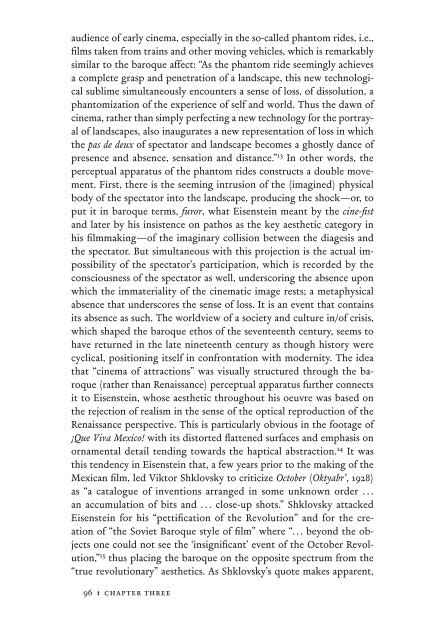In Excess: Sergei Eisentein's Mexico - Cineclub
In Excess: Sergei Eisentein's Mexico - Cineclub
In Excess: Sergei Eisentein's Mexico - Cineclub
Create successful ePaper yourself
Turn your PDF publications into a flip-book with our unique Google optimized e-Paper software.
audience of early cinema, especially in the so-called phantom rides, i.e.,<br />
fi lms taken from trains and other moving vehicles, which is remarkably<br />
similar to the baroque affect: “As the phantom ride seemingly achieves<br />
a complete grasp and penetration of a landscape, this new technological<br />
sublime simultaneously encounters a sense of loss, of dissolution, a<br />
phantomization of the experience of self and world. Thus the dawn of<br />
cinema, rather than simply perfecting a new technology for the portrayal<br />
of landscapes, also inaugurates a new representation of loss in which<br />
the pas de deux of spectator and landscape becomes a ghostly dance of<br />
presence and absence, sensation and distance.” 13 <strong>In</strong> other words, the<br />
perceptual apparatus of the phantom rides constructs a double movement.<br />
First, there is the seeming intrusion of the (imagined) physical<br />
body of the spectator into the landscape, producing the shock—or, to<br />
put it in baroque terms, furor, what Eisenstein meant by the cine-fi st<br />
and later by his insistence on pathos as the key aesthetic category in<br />
his fi lmmaking—of the imaginary collision between the diagesis and<br />
the spectator. But simultaneous with this projection is the actual impossibility<br />
of the spectator’s participation, which is recorded by the<br />
consciousness of the spectator as well, underscoring the absence upon<br />
which the immateriality of the cinematic image rests; a metaphysical<br />
absence that underscores the sense of loss. It is an event that contains<br />
its absence as such. The worldview of a society and culture in/of crisis,<br />
which shaped the baroque ethos of the seventeenth century, seems to<br />
have returned in the late nineteenth century as though history were<br />
cyclical, positioning itself in confrontation with modernity. The idea<br />
that “cinema of attractions” was visually structured through the baroque<br />
(rather than Renaissance) perceptual apparatus further connects<br />
it to Eisenstein, whose aesthetic throughout his oeuvre was based on<br />
the rejection of realism in the sense of the optical reproduction of the<br />
Renaissance perspective. This is particularly obvious in the footage of<br />
¡Que Viva <strong>Mexico</strong>! with its distorted fl attened surfaces and emphasis on<br />
ornamental detail tending towards the haptical abstraction. 14 It was<br />
this tendency in Eisenstein that, a few years prior to the making of the<br />
Mexican fi lm, led Viktor Shklovsky to criticize October (Oktyabr’, 1928)<br />
as “a catalogue of inventions arranged in some unknown order . . .<br />
an accumulation of bits and . . . close-up shots.” Shklovsky attacked<br />
Eisenstein for his “pettifi cation of the Revolution” and for the creation<br />
of “the Soviet Baroque style of fi lm” where “. . . beyond the objects<br />
one could not see the ‘insignifi cant’ event of the October Revolution,”<br />
15 thus placing the baroque on the opposite spectrum from the<br />
“true revolutionary” aesthetics. As Shklovsky’s quote makes apparent,<br />
96 : chapter three


